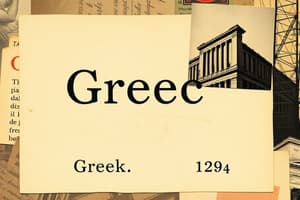Podcast
Questions and Answers
Who is credited with developing the COBOL programming language?
Who is credited with developing the COBOL programming language?
What is the origin of the term 'debugging'?
What is the origin of the term 'debugging'?
What is Charles Babbage known as?
What is Charles Babbage known as?
What was the purpose of the Mark II Aiken Relay Calculator?
What was the purpose of the Mark II Aiken Relay Calculator?
Signup and view all the answers
Who completed a portion of the Analytical Engine in 1901?
Who completed a portion of the Analytical Engine in 1901?
Signup and view all the answers
Who is the subject of an upcoming biopic to be released by Google and Middleton Media?
Who is the subject of an upcoming biopic to be released by Google and Middleton Media?
Signup and view all the answers
What was the primary contribution of Alan Turing during World War II?
What was the primary contribution of Alan Turing during World War II?
Signup and view all the answers
What is the significance of the Turing Machine?
What is the significance of the Turing Machine?
Signup and view all the answers
Who is often cited as the father of computers?
Who is often cited as the father of computers?
Signup and view all the answers
What was the significance of Konrad Zuse's Z3 machine?
What was the significance of Konrad Zuse's Z3 machine?
Signup and view all the answers
What was the primary purpose of ENIAC?
What was the primary purpose of ENIAC?
Signup and view all the answers
What was the approximate size of ENIAC?
What was the approximate size of ENIAC?
Signup and view all the answers
Study Notes
Pioneers in Computer Science
- Grace Murray Hopper is renowned for creating the first compiler and developing COBOL, a language used for government and business data processing for decades.
- She was a Rear Admiral of the US Navy.
Debugging Origin
- The term "debugging" originated from an incident where a two-inch moth caused a malfunction in the Mark II Aiken Relay Calculator at Harvard University on September 9, 1947.
- Hopper discovered and removed the moth from the relay, documenting the "first actual case of bug being found."
Mark II Computer
- The Mark II is an electromechanical computer designed by Mark Aiken and Hopper, along with other Mark computers.
- It was used for addition and multiplication to meet the computing needs of the United States.
Charles Babbage
- Charles Babbage is recognized as the inventor of the first computer, conceiving a steam-driven calculating machine, the Analytical Engine.
- Although the Analytical Engine was not built during his lifetime due to lack of funding, his son Henry completed a portion of the machine in 1901.
- The London Science Museum completed a working version of the Analytical Engine in 1991.
- Babbage is known as the "Father of the Computer" due to his radical ideas and concepts.
The Imitation Game
- The film "The Imitation Game" stars Benedict Cumberbatch as Alan Turing, a mathematical genius who played a pivotal role in decoding the German Enigma machine during World War II.
- The Enigma machine was a complex cipher system used by German forces for battlefield communication.
- Turing's efforts in breaking the Enigma code with the help of fellow mathematicians were instrumental in shortening the war and saving countless lives.
Alan Turing's Contributions
- Turing introduced the concept of the Turing Machine, considered the precursor to modern computers, in his 1936 paper "On Computable Numbers."
- This theoretical model of computation laid the foundation for computer science as we know it today.
- Turing is regarded as the father of modern computer science.
The First Modern Electromechanical Computers
- Konrad Zuse built the first working, programmable electromechanical digital computer, the Z3, in 1941.
- The Z3 was “Turing-complete,” meaning it could simulate any general-purpose computer, albeit slowly.
- Prior to the Z3, Zuse developed the Z1, a binary mechanical calculator, and the Z2, which used 600 telephone relays.
ENIAC
- ENIAC (Electronic Numerical Integrator and Calculator) is considered the first electronic computer for general-purpose use.
- It was developed from 1943 to 1946 to help calculate artillery firing tables for the US Army’s Ballistic Research Laboratory.
- ENIAC had a massive size, occupying almost 1800 square feet, and contained nearly 20,000 vacuum tubes and other components.
- It required 200 kilowatts of electricity and weighed over 30 tons.
Studying That Suits You
Use AI to generate personalized quizzes and flashcards to suit your learning preferences.
Description
Learn about the life and achievements of Grace Murray Hopper, a pioneering computer scientist who developed COBOL and served in the US Navy. Discover her contributions to the field of computer science and the origins of debugging.




